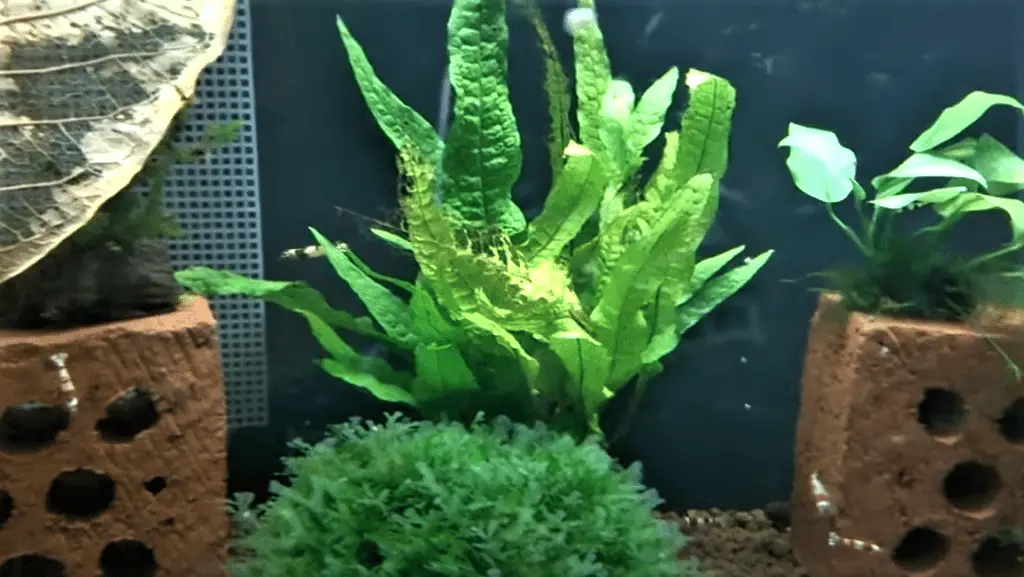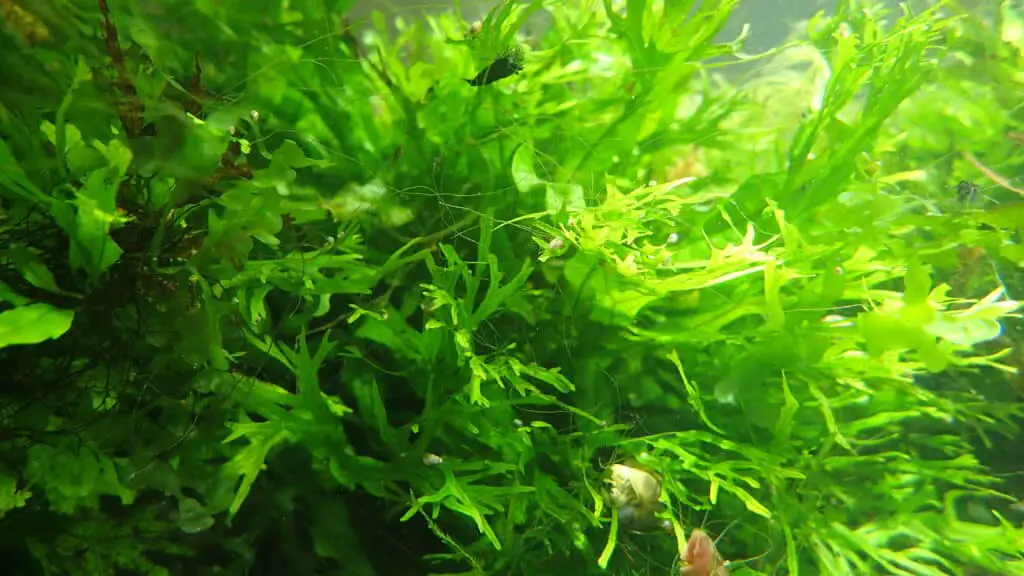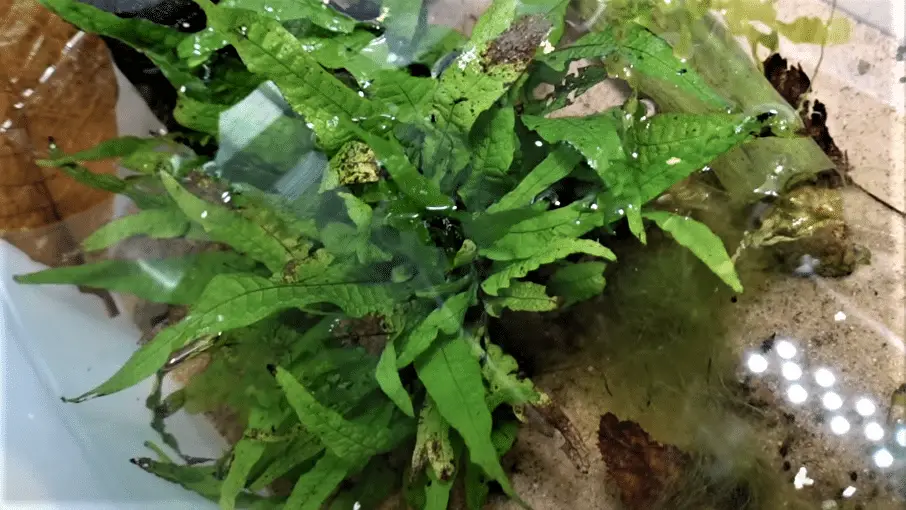Java Fern is grown by attaching it to a hard surface such as driftwood or rocks in your aquarium and ensuring it has moderate lighting and clean water.
As a seasoned shrimp keeper, I’ve had my fair share of challenges when it comes to maintaining the perfect environment for my little crustacean friends. One of the most memorable was my struggle with growing Java Fern.
I remember the excitement of introducing this beautiful, lush green plant into my aquarium as if it were yesterday, only to watch it struggle and fail to thrive. It was a frustrating few months, filled with trial and error, research, and a few tears shed over the seemingly simple task of growing a plant underwater.
But, as with all things in life, persistence paid off. After about six months of experimenting with different conditions, I finally cracked the code. As it turned out, the secret was not in the water temperature or the type of substrate I was using, but in the way the Java Fern was planted. This revelation was a game-changer, and since then, my aquarium has been a lush, green paradise, much to the delight of my shrimp.
In this blog post, I’ll share my journey and the lessons I learned along the way. I’ll guide you through the process of growing Java Fern, from choosing the right plant to the correct way of planting it, and how to care for it to ensure it thrives. So, please grab a cup of coffee, sit back, and let’s dive into the wonderful world of Java Fern.

The Importance of Choosing the Right Java Fern for Your Aquarium
Choosing the right Java Fern for your aquarium is a crucial first step in the journey of growing this beautiful aquatic plant. It’s akin to selecting the right ingredients for a recipe – the quality of what you put in directly influences the outcome.
Java Fern, scientifically known as Microsorum pteropus, comes in various types, each with its unique characteristics. Some popular varieties include the Narrow Leaf, Windelov, Trident, and Needle Leaf. Each of these varieties has its unique leaf shape and growth pattern, which can add a different aesthetic appeal to your aquarium.
When choosing a Java Fern, there are a few things you need to consider. First, look at the size of your aquarium. Some Java Fern varieties, like the Narrow Leaf, can grow quite tall, making them suitable for larger tanks. On the other hand, smaller varieties like the Windelov are perfect for nano tanks or as foreground plants in larger aquariums.
in larger aquariums.
Secondly, consider the inhabitants of your aquarium. If you’re a shrimp keeper like me, you’ll want to choose a variety that provides plenty of cover for your shrimp. With its dense growth and intricate leaf structure, Java Fern makes an excellent hiding spot for shrimp, helping them feel safe and secure in their environment.
Lastly, always inspect the plant before purchasing. Look for a healthy, vibrant green color, which indicates good health. Avoid plants with yellow or brown leaves, as these are signs of poor health or inadequate care. Also, check the rhizome – the thick, horizontal stem from which the leaves grow. It should be firm and healthy, not soft or mushy.
The right Java Fern enhances the beauty of your aquarium and contributes to a healthier and happier environment for your shrimp. So, take your time, do your research, and choose wisely. Your shrimp – and your eyes – will thank you for it.
The Correct Way to Plant Java Fern in Your Aquarium
Planting Java Fern in your aquarium isn’t quite like planting most other aquatic plants. It’s a bit of an oddball in the plant world, but that’s part of its charm.
You see, Java Fern doesn’t like to have its roots buried in substrate like most plants. Instead, it prefers to have its rhizome (the horizontal stem from which the leaves and roots grow) attached to a hard surface. This could be a piece of driftwood, a rock, or even a decoration in your aquarium.
Here’s the step-by-step process to correctly plant your Java Fern:
- Choose Your Surface: First, decide where you want your Java Fern to grow. This could be a piece of driftwood, a rock, or any other hard surface in your aquarium. The surface should be rough enough for the plant’s roots to grip onto.
- Prepare the Plant: Next, take your Java Fern and gently clean off any debris from the rhizome and roots. Be careful not to damage the roots in the process.
- Attach the Plant: Now comes the fun part – attaching the plant to the chosen surface. You can use fishing line, thread, or even aquarium-safe glue to do this. If you’re using fishing line or thread, simply wrap it around the rhizome and the surface a few times until the plant is secure. If you’re using glue, apply a small amount to the rhizome and press it onto the surface. Remember, you’re only attaching the rhizome, not the roots. The roots will eventually grip onto the surface on their own.
- Place in the Aquarium: Once the plant is secure, place the surface back into the aquarium. Ensure the Java Fern is positioned in an area with moderate light. Too much light can cause algae to grow on the leaves, while too little light can hinder growth.
- Patience is Key: Finally, be patient. Java Fern is a slow-growing plant, so it might take a while before you see new growth. But trust me, the wait is worth it. Over time, you’ll see new leaves sprouting from the rhizome, and the roots will start to grip onto the surface.
The key to successfully planting Java Fern is to attach it to a surface, not bury it in the substrate. This unique planting method allows the plant to absorb nutrients directly from the water, making it a great addition to any shrimp aquarium.

Ideal Conditions for Java Fern Growth
Java Fern, like any other plant, has specific conditions under which it thrives. Understanding these conditions and replicating them in your aquarium is key to successful Java Fern growth. Let’s delve into the ideal conditions for this resilient aquatic plant.
- Lighting: Java Fern is a low to medium light plant. This means it doesn’t require intense lighting to grow. In fact, too much light can lead to algae growth on the leaves, which can hinder the plant’s growth. If you notice algae on your Java Fern, it might be a sign that your aquarium is too brightly lit. Aim for about 8-10 hours of moderate light per day.
- Water Parameters: Java Fern is quite adaptable and can tolerate a wide range of water parameters. However, for optimal growth, aim for a pH between 6.0 and 7.5, and a temperature between 68°F and 82°F (20°C – 28°C). The plant can also tolerate a wide range of hardness levels, making it suitable for both soft and hard water aquariums.
- Nutrients: While Java Fern can survive in nutrient-poor conditions, it will thrive in an environment rich in nutrients. The plant primarily absorbs nutrients from the water column, so consider adding a liquid fertilizer to your aquarium. Look for a fertilizer that contains micronutrients like iron, as these are essential for the plant’s growth and color.
- Water Flow: Java Fern prefers a moderate water flow. Too strong a flow can damage the leaves, while too weak a flow can lead to debris accumulation on the plant. A moderate flow ensures the plant gets enough nutrients and CO2 from the water.
- Placement: As mentioned earlier, Java Fern should be attached to a hard surface like driftwood or rocks. Burying the rhizome in the substrate can cause it to rot. Also, ensure the plant is not overshadowed by other plants, as this can limit its access to light.
While Java Fern is a hardy and adaptable plant, providing it with the ideal conditions will ensure it grows lush and healthy, adding a touch of greenery to your aquarium and providing a safe haven for your shrimp.

Common Mistakes to Avoid When Growing Java Fern
Growing Java Fern can be a rewarding experience, but it’s not without its potential pitfalls. As with any endeavor, mistakes can happen, especially when you’re new to the process. Here are some common mistakes to avoid when growing Java Fern in your aquarium.
when growing Java Fern in your aquarium.
- Burying the Rhizome: This is perhaps the most common mistake made by aquarists. As we’ve discussed, Java Fern prefers to be attached to a hard surface, not buried in the substrate. Burying the rhizome can cause it to rot, leading to the plant’s demise.
- Overexposure to Light: While Java Fern does need light to photosynthesize, too much light can lead to algae growth on the leaves. This not only detracts from the plant’s appearance but can also hinder its growth. Aim for moderate lighting conditions for your Java Fern.
- Ignoring Water Parameters: Java Fern is a hardy plant and can tolerate a wide range of water parameters. However, extreme conditions can stress the plant and hinder its growth. Regularly check your aquarium’s pH, temperature, and hardness levels to ensure they’re within the ideal range for Java Fern.
- Neglecting Nutrient Needs: While Java Fern can survive in nutrient-poor conditions, it thrives in nutrient-rich environments. If you notice your Java Fern’s growth is slow or the leaves are losing their vibrant green color, it might be a sign of nutrient deficiency. Consider adding a liquid fertilizer to your aquarium to provide the necessary nutrients.
- Overcrowding: Java Fern needs space to grow. Planting it too close to other plants or decorations can limit its access to light and nutrients. Ensure your Java Fern has enough space to spread its leaves and grow.
- Impatience: Java Fern is a slow-growing plant. It’s not uncommon for aquarists to mistake this slow growth for a problem and start changing conditions or moving the plant around. Remember, patience is key. Give your Java Fern time to settle in and grow.
Avoiding these common mistakes can help ensure your Java Fern grows healthy and strong, adding a touch of lush greenery to your aquarium and providing a safe and comfortable environment for your shrimp.

How to Care for Your Java Fern Post-Planting
Once you’ve successfully planted your Java Fern, the journey isn’t over. In fact, it’s just beginning. Post-planting care is crucial to ensure your Java Fern thrives and becomes a beautiful addition to your aquarium. Here’s how to care for your Java Fern after planting:
- Monitor Lighting: Keep an eye on the lighting in your aquarium. As mentioned earlier, Java Fern thrives under moderate lighting conditions. Too much light can lead to algae growth on the leaves, while too little can hinder the plant’s growth. Aim for about 8-10 hours of moderate light per day.
- Check Water Parameters: Regularly check the water parameters in your aquarium. Java Fern prefers a pH between 6.0 and 7.5, and a temperature between 68°F and 82°F (20°C – 28°C). The plant can also tolerate a wide range of hardness levels. Regular monitoring will help you catch any deviations early and take corrective action.
- Provide Nutrients: Java Fern absorbs nutrients from the water column, so consider adding a liquid fertilizer to your aquarium. Look for a fertilizer that contains micronutrients like iron, which are essential for the plant’s growth and color.
- Maintain Moderate Water Flow: Ensure the water flow in your aquarium is moderate. Too strong a flow can damage the leaves, while too weak a flow can lead to debris accumulation on the plant. A moderate flow ensures the plant gets enough nutrients and CO2 from the water.
- Prune Regularly: Like any other plant, Java Fern benefits from regular pruning. This not only keeps the plant looking its best but also encourages new growth. Use a pair of sharp scissors to trim off any yellow or brown leaves. This will allow the plant to focus its energy on new growth.
- Be Patient: Finally, remember that Java Fern is a slow-growing plant. Don’t be discouraged if you don’t see new growth immediately. With the right conditions and care, your Java Fern will grow over time, adding a touch of lush greenery to your aquarium.
Post-planting care is crucial for the health and growth of your Java Fern. With the right care and a little patience, you’ll be rewarded with a beautiful, thriving plant that adds a touch of nature to your aquarium and provides a safe haven for your shrimp.

Troubleshooting Common Java Fern Problems
Despite our best efforts, problems can arise when growing Java Fern. But don’t worry, most issues are easily identifiable and can be resolved with a bit of troubleshooting. Here are some common Java Fern problems and how to address them:
- Brown or Yellow Leaves: This is often a sign of nutrient deficiency, particularly a lack of iron. Consider adding a liquid fertilizer that contains iron to your aquarium. If the problem persists, check your water parameters to ensure they’re within the ideal range for Java Fern.
- Algae Growth on Leaves: This is usually a sign of too much light or excess nutrients in the water. Reduce the amount of light your aquarium receives each day and consider using a timer to ensure consistent lighting periods. If the problem persists, check your feeding practices and consider reducing the amount of food you’re adding to the aquarium.
- Slow Growth or No Growth: Java Fern is a slow-growing plant, so don’t be alarmed if you don’t see immediate growth. However, if the plant shows no signs of growth over an extended period, it might be lacking nutrients. Consider adding a liquid fertilizer to your aquarium. Also, ensure the plant is receiving adequate light and the water parameters are within the ideal range.
- Leaves Falling Off: If the leaves of your Java Fern are falling off, it could be due to a few reasons. It could be a natural process where older leaves die off to make way for new ones. However, if you notice a significant amount of leaves falling off, it could be due to poor water conditions or a lack of nutrients. Check your water parameters and consider adding a liquid fertilizer to your aquarium.
- Rhizome Rot: If the rhizome of your Java Fern is soft or mushy, it’s likely rotting. This is often a result of burying the rhizome in the substrate. If this happens, remove the plant from the substrate and attach it to a hard surface in your aquarium.
The key to troubleshooting is observation. Regularly check your Java Fern and your aquarium conditions. The sooner you identify a problem, the sooner you can address it, and the better the chances your Java Fern has of bouncing back to its lush, green self.

Conclusion
Growing Java Fern in your aquarium can be a rewarding experience. This beautiful, hardy plant not only adds a touch of greenery to your aquarium but also provides a safe haven for your shrimp.
Remember, the key to successful Java Fern growth is choosing the right plant, planting it correctly, providing the ideal conditions, and avoiding common mistakes. With the right care and a little patience, you’ll be rewarded with a lush, thriving plant that enhances the beauty of your aquarium.
If you encounter any problems or have any questions along the way, please don’t hesitate to reach out. I’m here to help guide you through the process. If you can’t reach me here, check out the Aquarium Shrimp Keeping group on Facebook. It’s a wonderful community of shrimp keepers who are always willing to share their knowledge and experience.
Happy Shrimp Keeping!
FAQ
Q. Can Java fern be grown in soil?
A. No, Java Fern prefers to have its rhizome attached to a hard surface like driftwood or rocks. Burying the rhizome in the substrate, including soil, can cause it to rot.
Q. Can Java fern grow out of tank?
A. Yes, Java Fern can grow out of the tank in a partially-submerged fashion. However, it’s important to ensure that there’s high humidity around the plants at all times when grown this way.
Q. Does Java fern need fertilizer?
A. While Java Fern can survive in nutrient-poor conditions, it thrives in nutrient-rich environments. If you notice your Java Fern’s growth is slow or the leaves are losing their vibrant green color, it might be a sign of nutrient deficiency. Consider adding a liquid fertilizer to your aquarium to provide the necessary nutrients.
Q. Can you plant Java fern in gravel?
A. It’s not recommended to plant Java Fern in gravel or any other substrate. The plant prefers to have its rhizome attached to a hard surface. Burying the rhizome can cause it to rot.
Q. Can Java fern grow out of water?
A. Java Fern can grow out of water in a partially-submerged fashion, but it’s important to maintain high humidity around the plants at all times when grown this way.
